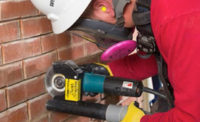In researching the standard, which was proposed in late August of this year, I looked through OSHA’s official “Notice of Proposed Rulemaking,” a 757-page document. Basically, OSHA’s proposal is to cut the exposure limit formula in half, to 50 micrograms of respirable crystalline silica per cubic meter of air (over an eight-hour day). In particular, the granite/stone industry is among those being targeted by OSHA, according to the document.
As supporting evidence for its proposal, OSHA cites a number of studies, including ones conducted on granite industry workers in the U.S., Canada and Europe. The most recent of these studies was conducted in 2007, while others date as far back as 1983, and the scientific justification for changing the standard at this time is not at all clear.
In fact, OSHA’s report states that from 1968 to 2002, the number of silicosis deaths among those aged 15 or higher decreased by 93%. It then dismisses this total, however, based on a 1989 study that cites “underreporting” of silicosis cases.
Only 1,943 stone fabricators?
The report also has a range of facts and figures on the stone fabrication industry, including the number of shops and assumed profit levels for an operation (5.49% across the board) as well as the estimated compliance costs that will result from the new standard.
Unfortunately, these numbers seem to be quite uninformed when it comes to assessing the U.S. stone fabrication industry. OSHA states that the U.S. has exactly 1,943 stone processors. This number is based on the U.S. Census Bureau designation of firms classified as “Cut Stone and Stone Product Manufacturing.” There are no other business designations in the entire 757-page report that would include stone fabricators.
It is extremely difficult to estimate how many stone fabricators there are in the U.S., but most educated estimates place the number between 10,000 and 12,000.
With this in mind, it is difficult to digest some of the figures that OSHA released as estimates for compliance — numbers such as profits, profits per entity and compliance cost as a percentage of profits.
Based on under 2,000 companies in the stone industry, OSHA estimates that the sector faces an annual cost of just over $8.6 million to be in compliance with the new regulations. However, because their estimated size of the industry is so grossly underestimated, it might be beneficial to look at OSHA’s figures on a per-operation basis. According to OSHA’s figures, the average annual costs for a company classified as “Cut stone and stone product manufacturing” would be $4,426, but this data is based on an overall industry-wide average and is not based on company size. OSHA estimates that individual companies in this category have an average revenue total of $1.9 million, with a profit rate of 5.49%. Thus, compliance would cost 0.23% of revenue and 4.2% of profit.
As for the size of individual operations, the U.S. Census Bureau classifies companies in the stone-related category with less than 500 employees as “small entities.” Given the typical makeup of a stoneworking firm, the vast majority of companies fall into this category, with 1,874 of the 1,943 companies (96.45%) having less than 500 employees. Overall, “small entities” are reported to have an average revenue total of $1.73 million and the same profit rate of 5.49%, and they would see slightly lower annual compliance costs of $4,284 — 0.25% of revenue and 4.51% of profit.
However, while 1,874 stoneworking companies have been classified as “small entities,” the OSHA report further classifies any businesses with less than 20 employees as “very small entities” — adding more complication to the overall compliance-cost data that has been released. A total of 1,471 companies (75.7%) fall into the “very small” category. These stoneworking operations show annual revenue of $946,566, according to OSHA, and run at the same overall profit level of 5.49%. For these companies, OSHA estimates annual compliance costs to be $1,872 per year, representing 0.20% of revenue and 3.6% of profit.
Looking at what OSHA thinks the industry will be spending for compliance, they feel that 68.49% of the additional costs will be for “engineering controls” within an operation, with another 21.28% going towards exposure assessment and the remainder going towards respirators, medical surveillance, establishing regulated areas and training.
Given the fact that most legitimate fabrication shops already cut and grind wet, it is unclear what these “engineering controls” would be.
Is working wet enough?
If you compare the latest OSHA report against previous reports, it would appear that the safety protocols are being adjusted without specific evidence as to why. The latest report includes the following statement on granite processing: “OSHA believes that wet methods alone will provide sufficient protection for shifts lasting four hours or less and is proposing to require the use of half-mask respirators with an APF of 10 for shifts lasting more than four hours.”
However, in 2009, an OSHA report entitled “Controlling Silica Exposures in Construction” did not recommend respirators for shifts lasting more than four hours:
“Wet grinding is highly effective in reducing silica exposures. Handheld water-fed grinding equipment is commercially available for concrete applications, granite grinding, and polishing operations. Conventional grinding equipment can be retrofitted to add a water-feed capability.”
It is important to note that the scientific studies cited in the August 2013 latest report were completed before the 2009 report came out, so it is unclear what prompted the required inclusion of a respirator as an additional safety measure for full shifts.
An uneven playing field for fabricators
In speaking with fabricators since OSHA’s proposal, the consensus seems to be that OSHA enforcement (of any kind) is lacking for shops that fly under the radar
— the ones with no licensing, insurance, etc. Meanwhile, the conscientious shops are the ones that get inspected and will have to adhere to whatever raised standards are put in place. Their feeling is that OSHA’s funding and efforts should focus more on enforcement of existing standards on an industry-wide basis. One fabricator said that their OSHA inspector seemed to be extremely inexperienced and only focused on “basics” like electrical cords and such. He summed up by saying: “There most certainly needs to be more enforcement on existing laws before more are passed.”
It is difficult to precisely quantify the number of fabricators in the U.S. — or even define “fabricator” — because of the potential low start-up costs. Someone can start a “shop” by purchasing a second-hand saw and portable edge router for a few thousand dollars. This, coupled with the ability to purchase slabs on consignment, makes it easy for these types of “low-ball” shops to exist. They are devaluing granite countertops by advertising prices as low as $19 (or less) per square foot, and they are universally considered to be the greatest challenge to that sector of the industry. From a safety standpoint, they are often cutting and grinding stone in a small rented space that is not equipped for wet cutting (or even outdoors), and they have no stake in the industry on any sort of long-term basis.
They are not looking at SIC/NAICS codes by the U.S. Census Bureau, and apparently, this leaves them off OSHA’s radar.
Fabricators are finding themselves frustrated in that they are not playing on a level playing field with shops like these when it comes to OSHA. The consensus is that whatever increased OSHA regulations are in place won’t affect these underground shops anyhow; they will only affect the above-board fabricators that are looking to do things right. The feeling is that OSHA should be allocating more resources to regulating the underground shops than to increasing regulations on legitimate ones.
The current silica standard
Going beyond OSHA’s limited view of the stone fabrication sector, there are serious questions as to why the standard is being changed. In a statement released by the Marble Institute of America (MIA) shortly after OSHA’s proposal was released, the organization disputed the need for any sort of change whatsoever.
“The MIA is urging OSHA to maintain current levels as they are appropriate if adhered to,” reads a statement released by the MIA. “Data from the U.S. Centers for Disease Control (CDC) show a greater than 90% reduction in the silicosis mortality rate from 1968 to 2010. It is doubtful that a further reduction of the allowable exposure limits will impact those numbers.
“Advances in wet cutting and stone industry education have positively aided OSHA in the effort to curb silica exposure during the past few years,” the statement continues. “The MIA believes that OSHA will continue to have a positive impact if attention is focused on compliance at the current exposure levels.”
“We consider ourselves partners with OSHA in this effort, and believe strongly that safety is paramount,” said James Hieb, MIA Executive Vice President, who pointed out that independent studies have estimated costs for construction industry compliance will exceed $1 billion per year. “Don’t hamper economic growth for companies who are in compliance at the current levels.”
It is important to note that the MIA has been extremely diligent in maintaining a partnership with OSHA, while also looking out for the best interests of the industry as a whole. It has also produced a number of training guides about silica, which have been reposted onto one page for easy viewing on its website — www.marble-institute.com/silica. They invite all stone groups to utilize the following as education and awareness resources:
- Silicosis: Incurable but Preventable (video available in English, Spanish and French)
- Silicosis: An Industry Guide to Awareness and Prevention (hardcopy technical module available in English and Spanish)
- Several toolbox talk training outlines on the topic of silica
Communication with OSHA
Despite OSHA’s lack of understanding of the U.S. stone industry, one positive is that it is encouraging feedback from fabricators — particularly on the new proposed silica standard. When the rulemaking proposal was released in August, Dr. David Michaels, Assistant Secretary of Labor, made a statement that reads, in part:
“This is a proposed rule and not a final rule. We are inviting and strongly encouraging the public to participate in the process of developing a final rule through submitting written comments and participating in public hearings that are scheduled to begin in Washington, DC, in early March. Our process of obtaining public input will take many months, and we encourage and welcome the public to participate.
OSHA’s objective is to develop a standard that not only protects workers, but also makes sense in the workplace. In this process, we especially hope to hear from workers and employers who have experience protecting workers from silica-related diseases.”
OSHA has established a 90-day comment period on the proposed silica standard, and the industry has until November 21 to participate. We encourage members of the natural stone industry — particularly those who quarry or process stone — to review this rule. To read about the rule, visit https://www.osha.gov/silica/. The “Public Participation” tab allows for commentary on the proposed rule.
While comment is expected from stone trade associations, stone fabricators are strongly urged to participate. A number of U.S. stone fabricators have been given “Star” recognition as part of OSHA’s Voluntary Protection Program (VPP), and they can contribute to positive dialogue with OSHA.








